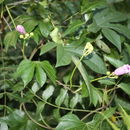en
names in breadcrumbs


The origin of Ipomoea mauritiana is unknown, but it may be in tropical America, where the nearest relatives occur.
Ipomoea mauritiana has often been misidentified as I. digitata (Linnaeus) Linnaeus, a West Indian endemic that does not occur in Asia.
Ipomoea mauritiana (lat. Ipomoea mauritiana) - sarmaşıqkimilər fəsiləsinin ipomeya cinsinə aid bitki növü.
Ipomoea mauritiana (lat. Ipomoea mauritiana) - sarmaşıqkimilər fəsiləsinin ipomeya cinsinə aid bitki növü.
Ipomoea mauritiana, deutsch auch Haiti-Prunkwinde genannt ist eine Pflanzenart aus der Gattung der Prunkwinden (Ipomoea) aus der Familie der Windengewächse (Convolvulaceae). Die Art ist pantropisch verbreitet.
Ipomoea mauritiana ist eine unbehaarte, an der Basis verholzende, oben krautige Kletterpflanze. Die Blattspreiten haben einen kreisförmigen Umriss, sind meist fünf- bis siebenmal (gelegentlich auch drei- bis neunmal) gelappt, selten sind sie ganzrandig. Sie haben eine Länge von 5 bis 8 cm, an der Basis sind sie herzförmig oder abgeschnitten. Die Lappen sind eiförmig, nach vorn spitz zulaufend, unbehaart oder mit vereinzelten Trichomen besetzt.
Die Blütenstände sind wenig- bis vielblütige Zymen. Die Kelchblätter sind fast lederig, unbehaart, kreisförmig oder elliptisch, deutlich konvex und die Krone umfassend und 6 bis 12 mm lang. Die Krone ist rötlich-violett bis rosa-pink gefärbt und 4 bis 6 cm lang.
Die Früchte sind eiförmige, 1,2 bis 1,4 cm lange Kapseln. Die Samen sind schwarz und schopfig behaart.
Die Chromosomenzahl beträgt 2n = 30.[1]
Die Art ist heute pantropisch verbreitet und ist meistens in Meeresnähe zu finden. Sie kam ursprünglich in Afrika und im tropischen Amerika vor.[2]
Innerhalb der Gattung der Prunkwinden (Ipomoea) ist die Art in die Serie Eriospermum der Sektion Eriospermum in der gleichnamigen Untergattung Eriospermum eingeordnet.[3]
Ipomoea mauritiana, deutsch auch Haiti-Prunkwinde genannt ist eine Pflanzenart aus der Gattung der Prunkwinden (Ipomoea) aus der Familie der Windengewächse (Convolvulaceae). Die Art ist pantropisch verbreitet.
Ipomoea mauritiana is a type of morning glory plant. Like the sweet potato, it belongs to the genus Ipomoea. It grows as a vine.
Its origins are uncertain, but it has been recorded in West Africa, including in Gambia[1] and the riparian forests of Benin,[2] as well as Australia's Northern Territory. It is naturalised in many parts of the world, including Taiwan.[3]
Specimens have been collected or observations taken in Australia, Belize, Benin, Brunei, Cambodia, Cameroon, China, Colombia, DRC, Costa Rica, Côte d'Ivoire, Ecuador, Equatorial Guinea, Gabon, Ghana, Guinea, Honduras, Indonesia, Laos, Liberia, Madagascar, Mauritius, Micronesia, Federated States of Myanmar, New Caledonia, Nicaragua, Nigeria, Panama, Papua New Guinea, Peru, Senegal, Sudan, Tanzania, Thailand, Togo and Venezuela.[4]
Ipomoea mauritiana is a type of morning glory plant. Like the sweet potato, it belongs to the genus Ipomoea. It grows as a vine.
Its origins are uncertain, but it has been recorded in West Africa, including in Gambia and the riparian forests of Benin, as well as Australia's Northern Territory. It is naturalised in many parts of the world, including Taiwan.
Specimens have been collected or observations taken in Australia, Belize, Benin, Brunei, Cambodia, Cameroon, China, Colombia, DRC, Costa Rica, Côte d'Ivoire, Ecuador, Equatorial Guinea, Gabon, Ghana, Guinea, Honduras, Indonesia, Laos, Liberia, Madagascar, Mauritius, Micronesia, Federated States of Myanmar, New Caledonia, Nicaragua, Nigeria, Panama, Papua New Guinea, Peru, Senegal, Sudan, Tanzania, Thailand, Togo and Venezuela.

Ipomoea mauritiana est une espèce de plantes dicotylédones de la famille des Convolvulaceae, tribu des Ipomoeeae, originaire des régions tropicales et subtropicales d'Afrique et d'Amérique, également présente en Asie et en Australasie. C'est une plante herbacée vivace aux racines tubéreuses et aux tiges volubiles pouvant atteindre 10 mètres de long.
Selon The Plant List (5 novembre 2019)[1] :
Ipomoea mauritiana est une espèce de plantes dicotylédones de la famille des Convolvulaceae, tribu des Ipomoeeae, originaire des régions tropicales et subtropicales d'Afrique et d'Amérique, également présente en Asie et en Australasie. C'est une plante herbacée vivace aux racines tubéreuses et aux tiges volubiles pouvant atteindre 10 mètres de long.
Akar lanar (Ipomoea mauritiana), kaledek hutan, akar laus (Melayu), widosari (Jawa Tengah),[1] akar keremek, akar kangkung laut, ubi jalar liar adalah tumbuhan obat dan juga flora Indonesia yang berkerabat satu genus dengan ubi jalar.[2]
Akar lanar merupakan suatu tanaman tahunan yang merambat, dapat mencapai 3-6 m. Ia berbentuk bulat, berrongga, hijau, dan membelit.[1][2] Daunnya berjenis tunggal, bersulur, berseling, berrongga, panjang 3-10 cm, berwarna hijau muda, berbentuk bulat ataupun jantung, berjumlah ganjil, ujungnya runcing, dengan pangkal tumpul, berukuran 6–20 cm × 5–18 cm, pertulangannya menyirip dan menjari. Permukaannya licin dan berwarna hijau. Bunganya berwarna ungu, majemuk, terkumpul dalam malai, berumah satu, kelopaknya terlepas, ujungnya runcing dengan bagian tengah berwarna lebih gelap.[2]
Akar lanar (Ipomoea mauritiana), kaledek hutan, akar laus (Melayu), widosari (Jawa Tengah), akar keremek, akar kangkung laut, ubi jalar liar adalah tumbuhan obat dan juga flora Indonesia yang berkerabat satu genus dengan ubi jalar.
Ipomoea mauritiana là một loài thực vật có hoa trong họ Bìm bìm. Loài này được Jacq. mô tả khoa học đầu tiên năm 1790.[1]
Ipomoea mauritiana là một loài thực vật có hoa trong họ Bìm bìm. Loài này được Jacq. mô tả khoa học đầu tiên năm 1790.
七爪龙(学名:Ipomoea mauritiana),又名掌叶牵牛、藤商陆、细种五爪龙、牛乳薯、千斤藤、栅手、五爪薯、野牵牛、野商陆、五爪龙、山东管、苦瓜藤,为旋花科番薯属的植物。分布在台湾岛、越南以及中国大陆的广西、云南、广东等地,生长于海拔280米至1,020米的地区,一般生于山地疏林、海滩边矮林或溪边灌丛,目前尚未由人工引种栽培。
|access-date=中的日期值 (帮助)